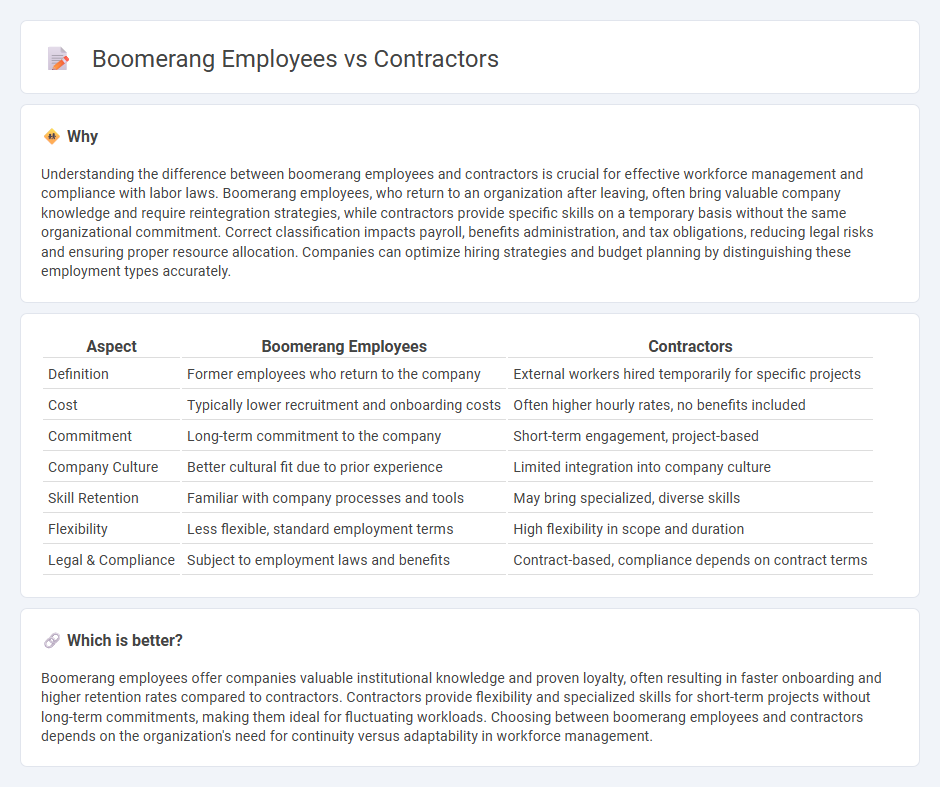
Boomerang employees are former staff members who return to a company, bringing familiarity with organizational culture and processes, which often leads to faster onboarding and higher retention rates. Contractors provide specialized skills for specific projects with flexible arrangements, reducing long-term employment costs but offering less stability for the workforce. Explore more about the distinct advantages and challenges of hiring boomerang employees versus contractors.
Why it is important
Understanding the difference between boomerang employees and contractors is crucial for effective workforce management and compliance with labor laws. Boomerang employees, who return to an organization after leaving, often bring valuable company knowledge and require reintegration strategies, while contractors provide specific skills on a temporary basis without the same organizational commitment. Correct classification impacts payroll, benefits administration, and tax obligations, reducing legal risks and ensuring proper resource allocation. Companies can optimize hiring strategies and budget planning by distinguishing these employment types accurately.
Comparison Table
| Aspect | Boomerang Employees | Contractors |
|---|---|---|
| Definition | Former employees who return to the company | External workers hired temporarily for specific projects |
| Cost | Typically lower recruitment and onboarding costs | Often higher hourly rates, no benefits included |
| Commitment | Long-term commitment to the company | Short-term engagement, project-based |
| Company Culture | Better cultural fit due to prior experience | Limited integration into company culture |
| Skill Retention | Familiar with company processes and tools | May bring specialized, diverse skills |
| Flexibility | Less flexible, standard employment terms | High flexibility in scope and duration |
| Legal & Compliance | Subject to employment laws and benefits | Contract-based, compliance depends on contract terms |
Which is better?
Boomerang employees offer companies valuable institutional knowledge and proven loyalty, often resulting in faster onboarding and higher retention rates compared to contractors. Contractors provide flexibility and specialized skills for short-term projects without long-term commitments, making them ideal for fluctuating workloads. Choosing between boomerang employees and contractors depends on the organization's need for continuity versus adaptability in workforce management.
Connection
Boomerang employees and contractors are connected through their non-linear work relationships, often returning to previous companies with enhanced skills or working on flexible contractual terms. Companies benefit from their familiarity with internal processes, reducing onboarding time and increasing productivity. This dynamic leverages organizational knowledge retention while adapting to evolving workforce models.
Key Terms
Employment Status
Contractors operate under independent agreements, offering flexibility and specialized skills without traditional employment benefits, while boomerang employees return to previous employers with established company knowledge and eligibility for full employment perks. Employment status affects tax withholding, legal protections, and access to company resources, making classification crucial for compliance and operational efficiency. Discover more about optimizing workforce structures by understanding these distinctions.
Rehire Policy
Companies differentiate contractors and boomerang employees based on their Rehire Policy, which defines eligibility criteria for former staff returning to the organization. Contractors typically undergo standard onboarding processes without rehire preferences, whereas boomerang employees benefit from streamlined rehiring due to proven performance and familiarity with company culture. Explore comprehensive rehiring strategies to optimize workforce management in your organization.
Worker Classification
Worker classification distinguishes contractors from boomerang employees based on control, independence, and duration of work relationship, impacting tax obligations and legal rights significantly. Contractors operate under their own business entities and manage their work methods, while boomerang employees return to a former employer, retaining employee status with associated benefits and protections. Explore more to understand the nuances of worker classification in workforce management.
Source and External Links
Houzz General Contractors - A platform to find and evaluate local general contractors for home improvement projects.
Contractor (Wikipedia) - An overview of different types of contractors, including general contractors and independent contractors.
Contractors State License Board (CSLB) - Regulates the construction industry in California by licensing and overseeing contractors.
 dowidth.com
dowidth.com